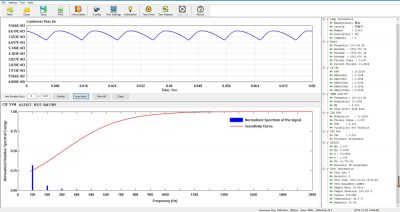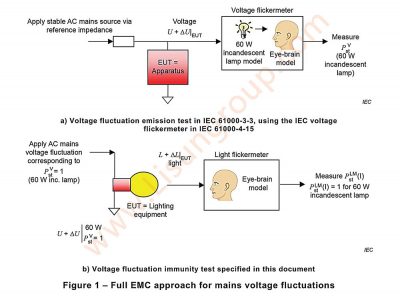Any lamps and lanterns may have “flicker“ when connected to AC power! Unless you don’t use batteries or transformers, lighting fixtures cannot avoid “strobe“, which is common in our lives.
What is alternating current? The current increases first in a cycle, then decreases when it reaches the peak value, and when it reaches 0, the power supply continues in the other direction. The characterization of the lamps is that the lamps change in two cycles of “bright and dark, bright and dark”, which can be regarded as an alternating current cycle. In the process of changing the AC current, the light output of the lamp will also change periodically.
That is to say, as long as the lamps and lanterns are connected to the AC power, there will be “stroboscopic“! This is an objective phenomenon. The “stroboscopic” of lighting fixtures can be recognized by the human eye, but also cannot be recognized by the human eye. When the light and dark changes of the lamps are fast enough to exceed the range of human eye recognition, the stroboscopic cannot be seen. There are stroboscopic flickers that can be recognized by the human eye, and there are stroboscopic flickers that do not have harmful effects. The same is true for strobes that the human eye cannot recognize. Our daily electricity is in the form of AC, with a frequency of 50 or 60 Hz, and the “flicker” of lamps is inseparable from AC power.

Flicker in daily life
The “flicker” of lighting fixtures is divided into whether there is harm or not, which can be recognized by the human eye and those that cannot be recognized by the human eye. When the light and dark changes of the lamps are fast enough to exceed the range of human eye recognition, the stroboscopic cannot be seen. For example, the above two PWM-driven light bulbs “flash” 1000 times per second, which are “harmless”.
The warning lights of mobile phone charging, the warning lights of medical vehicles, etc. are identifiable stroboscopic lights, which have no dangerous impact on biological health as a warning function, but are not suitable for main lighting.
Some low-quality lamps and lanterns, the human eye can not see the stroboscopic, but there may be photobiological hazards. This is the so-called “stroboscopic hazard” that is easy to ignore.
The research on stroboscopic hazards began in the 1950s. For human vision, periodic or aperiodic changes in brightness or color produced by luminous bodies or light reflectors in any visual field can be regarded as flicker or stroboscopic phenomena. Here are a few representative flicker or stroboscopic hazards:
1. Induce seizures in patients with photosensitive epilepsy (15-25Hz is the most serious);
2. Trigger or aggravate migraine (<75Hz);
3. Increase the repetitive behavior of autistic people (~60Hz);
4. Increase visual fatigue (~100Hz);
5. (>100Hz) Decreased physical judgment on motion: Under certain conditions, the continuously rotating object is regarded as static or discontinuous, or the motion direction is misjudged, etc., and the stroboscopic light source should be avoided on the machining site;
6. Athletes’ misjudgment of the trajectory of the ball target: it occurs in various frequency bands, depending on the speed, shape and appearance of the target;
7. Rebroadcasting and camera scene: the frequency band where strobe occurs can be expanded to within 3000Hz, depending on the speed of image acquisition. The influences are: bright and dark stripes, the overall light and dark instability of the picture, etc.
Strobes also exist in daily life, such as TVs, mobile phones, computers, etc. In order to meet the needs of the human eye, the output images of these video devices are mostly 15-60 frames per second. When people observe the video, they feel the change of the picture. It belongs to visual low-frequency flicker, staring at the video for a long time, which brings negative problems such as eye fatigue or may induce mental illness.
Taking some measures can reduce the negative effects of video equipment, such as: let the eyes rest for a certain period of time; keep a relative distance; appropriately reduce the brightness of the display screen; turn on the lights and watch TV to greatly reduce the stimulation of the screen flicker to the human eye (essentially reduce the video flicker ratio into the human eye).
IEEE Std 1786-2015 has two parameters for evaluating the stroboscopic flicker of lamps – the stroboscopic percentage (Percent flicker) and the flicker index (Flicker index).
1. Percent flicker
Also known as: Fluctuation Depth (FPF), Modulation Percentage, Modulation Depth (MD) among them, strobe percentage and Fluctuation Depth (FPF) are more commonly used in China. It is a parameter to evaluate the stroboscopic degree of lighting fixtures. The value is 0%~100%. The larger the value is, the more serious the stroboscopic.
The definition of strobe percentage is: in a fluctuation period, the ratio of the difference between the maximum value and the minimum value of the light output to the sum of the maximum value and the minimum value of the light output, expressed as a percentage.
2. Flicker index
The value of the area on the average light line divided by the area of the entire light output curve over a period. Evaluate the stability of the light output waveform. The value ranges from 0.0 to 1.0. The larger the value, the more unstable the light output of the lamp and the more serious the stroboscopic.

IEEE Std 1789-2015 Low-risk limits for percent flicker in lamps
There is less attention to the stroboscopic flicker of lighting fixtures in China, and the national standards for the stroboscopic limit value of lighting fixtures have relevant regulations, but there are no mandatory requirements. The current GB/T31831 “Technical Application Requirements for LED Indoor Lighting” refers to IEEE, and the limit of no flicker for lamps is stipulated as follows:
In the upcoming new regulation CQC1601-2016 “Technical Specifications for Visual Work Desk Lamp Certification”, the stroboscopic limit of lamps is directly referred to IEEE Std 1789-2015. That is, the strobe percentage of lamps can be in the low risk range.
Under the frequency of AC 50Hz, the stroboscopic frequency of general lamps is 100Hz: the stroboscopic percentage is lower than 3.2%, which is the limit range of no stroboscopic hazard; the stroboscopic percentage is lower than 8%, which is within the low-risk range and belongs to the safe range; If the stroboscopic percentage is higher than 8%, the lighting product can be regarded as unsafe.
Lamp Start and Run-up Test: Please click here to see the Lamp Start and Run-up Test Report Sample. The LSRF-3 needs to work with LISUN’sLSP-500VARC AC Power Source (With Trigger Function) or LSP-500VARC-Pst (IEC-Pst AC Power Source)to test the Start and Run-up time of lamps which is according to clause 11.4 Start Time Test Method&clause 11.5 Run-Up Time Test Methodin the US Standards of Energy Star V2.1, andSASO2902Table 13:

CIE SVM ASSIST IEEE Std1789 test report
According to IEC TR 61547-1:2020, The LSRF-3 do the Light Pst V measure on AC Stable as below Figure 1a , and also can do the Light Pst LM(I) measure on AC Fluctuation as below Figure 1b. Note: The Light Pst LM(I) measurements need to work with LISUN’s LSP-500VARC-Pst (IEC-Pst AC Power Source)

Light Pst Lm I Flicker Test Principle
Lisun Instruments Limited was found by LISUN GROUP in 2003. LISUN quality system has been strictly certified by ISO9001:2015. As a CIE Membership, LISUN products are designed based on CIE, IEC and other international or national standards. All products passed CE certificate and authenticated by the third party lab.
Our main products are Goniophotometer, Integrating Sphere, Spectroradiometer, Surge Generator, ESD Simulator Guns, EMI Receiver, EMC Test Equipment, Electrical Safety Tester, Environmental Chamber, Temperature Chamber, Climate Chamber, Thermal Chamber, Salt Spray Test, Dust Test Chamber, Waterproof Test, RoHS Test (EDXRF), Glow Wire Test and Needle Flame Test.
Please feel free to contact us if you need any support.
Tech Dep: Service@Lisungroup.com, Cell/WhatsApp:+8615317907381
Sales Dep: Sales@Lisungroup.com, Cell/WhatsApp:+8618117273997
Your email address will not be published. Required fields are marked *